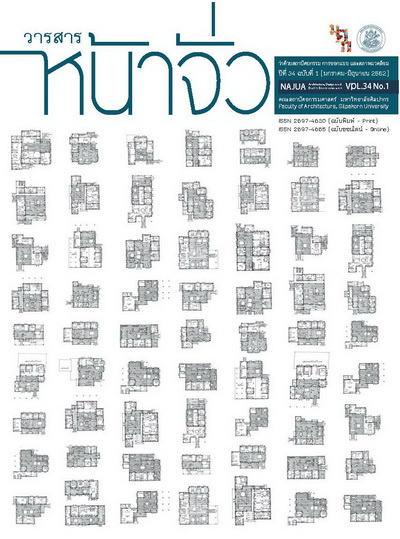Chronology of Vernacular Architecture Study in Thailand: a Significant Movement
Keywords:
Vernacular ArchitectureAbstract
Chronology of Vernacular Architecture Study in Thailand: a Significant Movement
Amarit Muadthong
Doctor of Philosophy Program in Vernacular Architecture, Faculty of Architecture ,Silpakorn University
Supitcha Tovivich
Faculty of Architecture ,Silpakorn University
Ornsiri Panin
Faculty of Architecture ,Kasetsart University
This article aims at explaining the chronology of vernacular architecture study in Thailand through academic studies during 1939-2006 in order to signify the status of the knowledge and attitudes towards bodies of knowledge in Thailand and to compare with the international contexts. There are three categories of periodical development which are 1.) the beginning: exploration and collection of bodies of knowledge; 2.) further studies to development by comparing with international contexts and the derivation of “vernacular architecture”; and 3.) guidelines for further studies.
When the studies were compared under international contexts, the adaptation was figured out, from only structural construction to its surroundings, along with interdisciplinary approaches, especially in terms of anthropology. There were also important aspects to be focused on. In other words, cultural landscapes, comprising ordinary ways of life and the architecture, were more focused. For further studies in the future, aspects about vernacular architecture need to relate to issues which vary through the changing world. In addition, theories, principles, and guidelines need to be revised with critical discourse analyses to cover all related aspects.
References
ภาษาไทย
- Horayangkura,Vimolsiddhi and the others. (1993). Satanapap pon khan wichakarn Saka Sathapattakam Nai Pratet Thai. (In Thai) [The status of Academic Outputs in Architecture in Thailand]. BKK: National research council of Thailand.
- Inpuntung, Vira. (2004). Sathapattakam Nai Wattana Tham Koa. (In Thai) [Vernacular Architecture in Rice Culture]. BKK: Faculty of Architecture, Silpakorn University.
- Panin, Ornsiri.(Eds) Local wisdom in House, communities, and cultural ecology for sustainable living of Thai people in Western Region. (In English), BKK: Faculty of Architecture, Silpakorn University.
- Oranratmanee, Rawiwan. (2009). Sathapattakam Phuntin Kan suk sa vijai Lae patipat wichacheep Sathapattakam. (In Thai) [Vernacular Architecture: Architectural Education, Research and Practice] Arch journal Issue 2009 (8),56-66.
- Panin, Ornsiri and the others (2002). Pramern Satanapap Thai suk sa saka Sathapattakam Silpakam lae Huttakam(In Thai) [The Evaluation of the status of Thai studies in Architecture,Art,and Crafts]. BKK: Faculty of Architecture, Silpakorn University.
- Panin, Ornsiri. (2006). “Kan anurak lae pattana thongthin yang yung yuen”(In Thai) [Sustainable Local Heritage Conservation: The Transdisciplinary Approach]” Rattanachaiyanon, Russamee. (Eds.) Proceeding of International Conference: Sustainable Local Heritage Conservation: The Trandisciplinary Approach and ICOMOS Thailand Annual Meeting 2006.
- Pimonsatien, Yongthanit. (2005) Si Sip Pee lung Venice charter. (In Thai) [40th years after Venice charter]. Rattanachaiyanon, Russamee. (Eds.) Proceeding Scientific Seminar on 2 Decade of ICOMOS Thailand: cultural heritage Conservation Towards Thailand Charter on Conservation and ICOMOS Thailand Annual Meeting 2005 25-26 November 2005.
- Rabibhadana, Akin. (1999). Chumchon aae aad oong Khwam ru kub Khwam pen jing. (In Thai) [Slums: knowledge and truth]. BKK: The Thailand Research Fund.
- Sateinnam, Tanit and Tungsakul Nopadol. (2014). “Hok Krabuantat Naikan suksa Sathapattakam Phuntin (In Thai) [Six Paradigms in the Vernacular Architectural Study]”. Najua: Sathapattayakam Kanokbab lae Sapapwatlom [Najua: Architecture Design and Built Environment] (28), 265-278.
- Srisuro, Wiroj. (2000). “Sathapattakam Phuntin Nun Samkhan chanai. (In Thai) [The Importance of Vernacular Architecture]”. Tundikul, Chinasak (Eds) Khwam Lak Lai khong Ruen Phuntin Thai. (In Thai),Bangkok: Faculty of Architecture, Silpakorn University.
- Tewakul Taweepransiporn, Piyalada. (2014). Kham Kwamkhit Sathapattayakham. (In Thai) BKK: Li-zen.
- Temiyapan, Wiwat. (1987). Naew Tang Karn Suk sa Sathapattakam Phuntin (In Thai) [The approach of Vernacular Architecture study in Thailand] Heng rasamee, Thiti (Eds) Sathapattakam Isan. (In Thai) Khonkaen: Faculty of Architecture, Khonkaen University.
- Tovivich, Supitcha. (2000). Occupied Spaces and Material Used in Urban Poor Houses. (In English) Master in Architecture of Architecture, Silpakorn University.
- Temiyapan, Wiwat. (2016). Sapap wadlom thongthin Thai. (In Thai) [The Importance Knowledge of local environment in Thailand] Kietpaiboon,Komsan.(Eds.) Sathapattakam Phuntin (In Thai). BKK: Triple group.
- Wiboonsawad Handerson, Wannee. (1977). Silpakhampunthin. (In Thai) [Folk Art and Crafts] Borankadee (Archaeology). 7 (2), 4-15.
- Wongwipak, Chanan. (1989). Niwes wattatham. (In Thai) [Cultural Ecology]. BKK: Silpakorn University.
ภาษาอังกฤษ
- Asquith, Linsay and Vellinga, Marcel. (2006). Vernacular Architecture in the Twenty-First Century. USA: Taylor & Francis.
- Rudofsky, Bernard. (1964). Architecture without architects: A short introduction to non-pedigreed Architecture, Doubleday &Company, Garden City, New York.
- Alsayyad, Nezar. (2006). “Foreword” in Vernacular Architecture in the Twenty-First Century. USA: Taylor & Francis: xvii-xviii.
- Oliver, Paul. (1997). Encyclopedia of Vernacular Architecture of the world. Cambridge: Cambridge University Press.
- Oliver, Paul. (2006). “Afterword; Raising the roof”. in Vernacular Architecture in the Twenty-First Century. USA: Taylor & Francis: 265-268.
- Rapoport, Amos. (1969). House form and culture. USA: Prentice-Hal, Inc.
เว็บไซต์
- Hayward. M.E. (1981). Urban vernacular Architecture in Nineteenth-century Baltimore. Retrieved August 16, 2017, from www.journals.uchicago.edu/doi/pdfplus/10.1086/496001
- Princess Maha Chakri Sirindhorn Anthropology Centre. (2016). Built Environment. Retrieved July 21, 2016, from www.sac.or.th./database/anthropologyconcept
- Polanyi Michael. (1966). Informal knowledge, from William H. Zaggle ,The Rise of Informal Knowledge and the Teacher’s Evolving Role. Retrieved June 26, 2018, from https://etcjournal.com/2011/06/15/the-rise-of-informal-knowledge-and-the-teachers-evolving-role/




